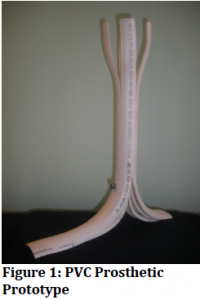Kyle Smith and Dr. Mark Colton, Mechanical Engineering Dept
Introduction
The purpose of this project was to develop a simple process to manufacture a useful and affordable prosthetic leg to be made available to below-the-knee amputees in a sub-Saharan African country. This project was motivated by a desire for learning and experience and also by humanitarian and social entrepreneurship ideals. The project was carried out as a joint effort by a larger research team composed of members of the BYU Biomedical Engineering Club. As this was a joint team effort, many of the tasks detailed in this report were shared between several team members. Currently, the team has identified partners in Deseret International, a non-profit organization, to implement our product in Uganda. Although product development is inherently an integrated task involving customer needs, design requirements, and constraints of manufacturing, materials, and cost, this report focus on the specific tasks completed to develop the manufacturing process
Task Completion
The proposal specified four components necessary to the success of the project: 1) Develop a thorough and working understanding of the available manufacturing processes in Africa, 2) Develop a specific manufacturing process, 3) Simulate the process and produce several prosthetics, and 4) Refine the process to make it simple and feasible. We will detail progress on these four project components.
1) Develop an understanding of available manufacturing processes in Africa
Through a contact in Africa, we were able to establish correspondence with Sister Elizabeth Nsawam, a volunteer at a Catholic prosthetic clinic in Ghana. By exchange of emails and phone conversations with Nsawam, we developed an understanding of the processes and materials currently used in the Catholic clinic, and in other similar clinics in Ghana. As expected, we discovered that most clinics employ relatively rudimentary materials and processes, and most prosthetics are hand carved from wood using hand tools, with the method of attachment for the prosthetic to the stump being a hand-cut leather strap with a buckle. Through our correspondence with Nsawam, we also established an understanding of the expectations and aesthetic requirements of a prosthetic leg in the culture of sub-Saharan Africa.
We also utilized the resources available through the Harold B. Lee Library to survey manufacturing processes available in Africa. Existing research on this topic is limited, but we located some sources focused on economic development that provided the information we needed. We found, as expected, that the manufacturing resources available were limited to rudimentary procedures mainly involving hand tools.
2) Develop a specific manufacturing process
We went through several design iterations to arrive at what we believe is a suitable design. As mentioned, most existing prosthetics in Africa are made from hand-carved wood. We decided to experiment with different materials to see if the manufacturing processes required for those materials were feasible. We first attempted a design from steel plates of the size that would be available as scrap from automobile shocks. We performed finite element analysis on various steel designs to ensure the foot could hold the required loads of typical prosthetic use. Although steel provides adequate strength and fatigue properties, manufacturing a steel foot would require time and labor intensive forging processes (i.e. beating the steel with a hammer on an anvil). The steel was also too heavy to be suitable as a prosthetic.

We moved onto a design made entirely from standard PVC pipes (Figure 1). We adopted a leaf-spring design that integrated both the toe and the heel portion of the foot in one piece of PVC. All manufacturing processes required for the PVC design can be accomplished with reasonable effort using hand tools (saws, hand drills, and files). Bending the PVC into the socket shape at the top of the leg can be accomplished by placing the PVC in an oven for a short period of time then forming the PVC with gloved hands around a wooden form.
3) Simulate the process and produce several prosthetics
We have produced several PVC prosthetic prototypes, and through iteration are approaching a suitable design. The manufacturing process is complete—All variations at this point are made in the product design with the manufacturing process unchanged.
4) Refine the process to make it simple and feasible
Through the iteration process, we have streamlined manufacture of several of the PVC parts. The simplification process has mainly involved standardizing sizes and measurements of parts, cuts, and hole sizes.
Concluding Thoughts
This research certainly provided several opportunities to expand classroom learning into a real world application. We have applied manufacturing and problem solving skills to produce prototypes and manufacturing processes for a prosthetic leg. In a broader context, this project has been extremely valuable to become aware of the challenges involved in creating a social enterprise. The problem of solving a social problem is certainly complex and involved, and it is necessary to be fully aware of circumstances and resources to ensure that the effort is beneficial, and not detrimental, to the people the project intends to assist. The results of this research and other research completed by the group will be presented by David Williams at the 2010 Utah Conference on Undergraduate Research held at Southern Utah University.
